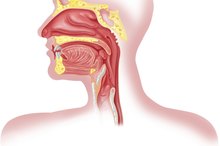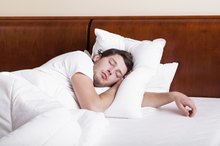Mouth Breathing Vs. Nasal Breathing
Certain individuals, whether children or adults, have a tendency to breathe through the mouth instead of the nose. Whether you are exercising, sleeping or going about daily life, it is preferable to do nasal breathing rather than mouth breathing. When you breathe through your mouth, your brain is tricked into thinking that carbon dioxide is escaping the body too quickly. This stimulates the production of mucous, as the body attempts to slow the breathing.
Nasal Breathing
Nasal breathing is healthier than mouth breathing for several reasons. Your lungs take oxygen from the air, and absorption of oxygen happens mostly on exhalation. Exhaling through the nose, which is smaller than the mouth, creates greater air pressure and therefore a slower exhalation. This gives the lungs extra time to extract a greater amount of oxygen.
- Nasal breathing is healthier than mouth breathing for several reasons.
- Exhaling through the nose, which is smaller than the mouth, creates greater air pressure and therefore a slower exhalation.
Mouth Breathing
Functions of the Nose
Learn More
Mouth breathing is common in individuals whose nasal passages are blocked or restricted. For example, a deviated septum or small nostril size can lead a person to breathe primarily through the mouth instead of the nose. Breathing through the mouth is inefficient, however, and leads to hyperventilation. This, in turn, causes or worsens symptoms of asthma, heart disease and high blood pressure.
- Mouth breathing is common in individuals whose nasal passages are blocked or restricted.
- This, in turn, causes or worsens symptoms of asthma, heart disease and high blood pressure.
Exercise
Nasal breathing is more efficient than mouth breathing in terms of supplying oxygen to the body. When performing cardiovascular exercise, it is therefore preferable to inhale and exhale through the nose. If you are exercising and become out of breath, it is faster to exhale through the mouth than the nose, but this will reduce the amount of oxygen extracted from each exhalation. Additionally, the nostrils and sinuses play a part in filtering and warming the air that is inhaled into the lungs. This filtering effect is helpful in keeping bacteria and particles out of your body. When exercising in chilly weather, breathing through the nose prevents cold air from going straight to your lungs and causing chest and throat pain.
- Nasal breathing is more efficient than mouth breathing in terms of supplying oxygen to the body.
- If you are exercising and become out of breath, it is faster to exhale through the mouth than the nose, but this will reduce the amount of oxygen extracted from each exhalation.
Snoring
How to Increase Your Body's Oxygen Intake
Learn More
Breathing through the mouth rather than the nose during sleep is associated with loud snoring. This happens because of the way that breathing is regulated by nerves in the nasal passages. An area of the nose known as the nasal mucosa is a sensor for inhaled air, and when nasal breathing occurs, the nasal mucosa sends stimuli to the breath-controlling reflex nerves. When mouth breathing occurs, the nasal mucosa does not send these stimuli to the reflex nerves, and this can result in an irregular breathing pattern. This can lead to heart conditions or the development of sleep apnea, in which a lack of breathing regulation causes short periods of suffocation.
- Breathing through the mouth rather than the nose during sleep is associated with loud snoring.
- When mouth breathing occurs, the nasal mucosa does not send these stimuli to the reflex nerves, and this can result in an irregular breathing pattern.
Increasiing Nasal Breathing
Concentrating on nasal breathing throughout the day will help you increase nose breathing and reduce mouth breathing. Meditation and breathing exercises can also help; because the nose is smaller than the mouth, nasal breathing is inherently slower than mouth breathing and will help reduce stress and hypertension. If mouth breathing while sleeping is a problem, try using nasal strips, which fit like a bandage over the bridge of the nose and open the nasal airways to promote breathing through the nose rather than the mouth. Other snoring remedies are available which work to reduce nasal breathing.
- Concentrating on nasal breathing throughout the day will help you increase nose breathing and reduce mouth breathing.
- If mouth breathing while sleeping is a problem, try using nasal strips, which fit like a bandage over the bridge of the nose and open the nasal airways to promote breathing through the nose rather than the mouth.
Related Articles
References
- "Proceedings of the Royal Society of Medicine"; Discussion on Mouth-Breathing and Nasal Obstruction; June 1932
- Optimal Breathing: Nose Breathing Has Many Benefits Over Mouth Breathing
- Recinto C, Efthemeou T, Boffelli PT, Navalta JW. Effects of Nasal or Oral Breathing on Anaerobic Power Output and Metabolic Responses. Int J Exerc Sci. 2017;10(4):506-514.
- Cancelliero-gaiad KM, Ike D, Pantoni CB, Borghi-silva A, Costa D. Respiratory pattern of diaphragmatic breathing and pilates breathing in COPD subjects. Braz J Phys Ther. 2014;18(4):291-9. doi:10.1590/bjpt-rbf.2014.0042
- Cleveland Clinic. Diaphragmatic Breathing. 2019.
- Giuliodori MJ, Lujan HL, Briggs WS, Dicarlo SE. A model of locomotor-respiratory coupling in quadrupeds. Adv Physiol Educ. 2009;33(4):315-8. doi:10.1152/advan.00057.2009
- Daley MA, Bramble DM, Carrier DR. Impact loading and locomotor-respiratory coordination significantly influence breathing dynamics in running humans. PLoS ONE. 2013;8(8):e70752. doi:10.1371/journal.pone.0070752
- Schücker L, Parrington L. Thinking about your running movement makes you less efficient: attentional focus effects on running economy and kinematics. J Sports Sci. 2019;37(6):638-646. doi:10.1080/02640414.2018.1522697
- Stickford AS, Stickford JL, Tanner DA, Stager JM, Chapman RF. Runners maintain locomotor-respiratory coupling following isocapnic voluntary hyperpnea to task failure. Eur J Appl Physiol. 2015;115(11):2395-405. doi:10.1007/s00421-015-3220-y
- Bramble, D., & Carrier, D. (1983). Running and breathing in mammals. Science, 219(4582), 251–256. doi:10.1126/science.6849136
- Ramos-Jiménez, A., Hernández-Torres, R. P., Torres-Durán, P. V., Romero-Gonzalez, J., Mascher, D., Posadas-Romero, C., & Juárez-Oropeza, M. A. (2008). The Respiratory Exchange Ratio is Associated with Fitness Indicators Both in Trained and Untrained Men: A Possible Application for People with Reduced Exercise Tolerance. Clinical medicine. Circulatory, respiratory and pulmonary medicine, 2, 1–9. doi: doi.org/10.4137/ccrpm.s449
- Recinto, C., Efthemeou, T., Boffelli, P. T., & Navalta, J. W. (2017). Effects of Nasal or Oral Breathing on Anaerobic Power Output and Metabolic Responses. International journal of exercise science, 10(4), 506–514. PMID: 28674596
- Schücker, L., & Parrington, L. (2018). Thinking about your running movement makes you less efficient: attentional focus effects on running economy and kinematics. Journal of Sports Sciences, 37(6), 638–646. doi:10.1080/02640414.2018.1522697
- Stickford, A. S. L., Stickford, J. L., Tanner, D. A., Stager, J. M., & Chapman, R. F. (2015). Runners maintain locomotor–respiratory coupling following isocapnic voluntary hyperpnea to task failure. European Journal of Applied Physiology, 115(11), 2395–2405. doi:10.1007/s00421-015-3220-y
- TAKANO, N. (1995). Phase Relation and Breathing Pattern during Locomotor/Respiratory Coupling in Uphill and Downhill Running. The Japanese Journal of Physiology, 45(1), 47–58. doi:10.2170/jjphysiol.45.47
- Daley MA, Bramble DM, Carrier DR. Impact Loading and Locomotor-Respiratory Coordination Significantly Influence Breathing Dynamics in Running Humans. Hug F, ed. PLoS ONE. 2013;8(8):e70752. doi:10.1371/journal.pone.0070752.
- Morton D, Callister R. Exercise-Related Transient Abdominal Pain (ETAP). Sports Medicine (Auckland, N.z). 2015;45:23-35. doi:10.1007/s40279-014-0245-z.
- Sato K, Shirakawa T, Sakata H, Asanuma S. Effectiveness of the analysis of craniofacial morphology and pharyngeal airway morphology in the treatment of children with obstructive sleep apnoea syndrome. Dentomaxillofac Radiol. 2012;41(5):411–416. doi:10.1259/dmfr/28710443
- Azarbarzin A, Sands SA, Marques M, et al. Palatal prolapse as a signature of expiratory flow limitation and inspiratory palatal collapse in patients with obstructive sleep apnoea. Eur Respir J. 2018;51(2):1701419. doi:10.1183/13993003.01419-2017
- Leboulanger N. Nasal obstruction in children. Eur Ann Otorhinolaryngol Head Neck Dis. 2016;133(3):183-6. doi:10.1016/j.anorl.2015.09.011
- May JR, Dolen WK. Management of allergic rhinitis: a review for the community pharmacist. Clin Ther. 2017;39(12):2410-2419. doi:10.1016/j.clinthera.2017.10.006
- Wheatley LM, Togias A. Clinical practice. Allergic rhinitis. N Engl J Med. 2015;372(5):456–463. doi:10.1056/NEJMcp1412282
- Rowland S, Aiyappan V, Hennessy C, et al. Comparing the efficacy, mask leak, patient adherence, and patient preference of three different CPAP interfaces to treat moderate-severe obstructive sleep apnea. J Clin Sleep Med. 2018;14(1):101-108. doi:10.5664/jcsm.6892
Writer Bio
Jae Allen has been a writer since 1999, with articles published in "The Hub," "Innocent Words" and "Rhythm." She has worked as a medical writer, paralegal, veterinary assistant, stage manager, session musician, ghostwriter and university professor. Allen specializes in travel, health/fitness, animals and other topics.








